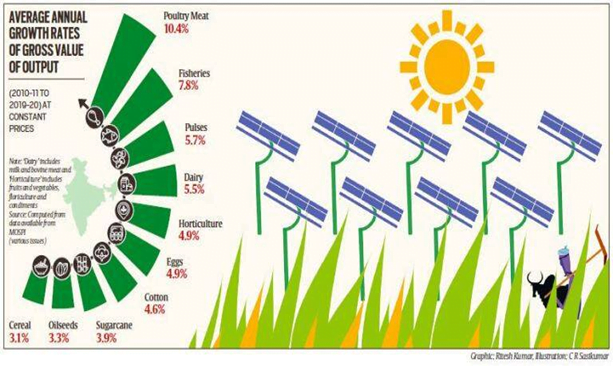Environment & Ecology
- Context: By making solar energy the ‘third crop’, promoting this innovation on a mission mode, the government can double farmers’ income.
- Recently, India celebrated 75 years of Independence and entered the Amrit Kaal toward 2047.
- The famous slogan of late Lal Bahadur Shastri, “Jai Jawan, Jai Kisan,” was extended by Atal Bihari Vajpayee to include “Jai Vigyan.” Now, our current Prime Minister has extended it to, “Jai Anusandhan”.
Challenges with respect to growing population and availing the food:
- As per the latest UN Population reports, India is likely to surpass China by 2023. So, the biggest challenge will be feeding a country whose per capita income still hovers around $2,300.
- The per capita income is likely to grow between 5 to 6 per cent per annum, under normal conditions.
- As they rise from low-income levels, people are likely to demand not just more food but safe and nutritious food.
- So, the first challenge would be to align our Agri-policies and strategies to the emerging demand pattern.

The above infographic shows that:
- Poultry and fisheries have the fastest growth, while it has been the slowest in cereal production despite regular Government intervention is the most in cereals through the massive procurement of rice and wheat under MSP.
- While those sub-sectors of agricultural economy that rely on market forces, no matter how imperfect, still perform better.
We need to focus on the food system as a composite entity. It has five dimensions:
- Production, marketing, and consumption is the traditional part of the food system and need to add two more.
- The environmental sustainability of our food systems and their nutritional outcomes.
- As in the past, The Green Revolution of the 1960s brought about a marked improvement in the yield of agricultural crops such as rice and wheat.
- However, intense use of irrigation, chemical fertilizers and pesticides lead to negative environmental consequences.
Promotion of climate-resilient and environment sustainable agriculture.
- To check on declining groundwater table, rejuvenate our soils, and Carbon markets need to be developed so that farmers can be incentivized to change existing farming practices that are not compatible with environmental sustainability.
- Adaptation of digital technology (e-technology in the aid of farmers) will help in better adaptation and implement of this initiative. We need to become a nation of innovators in agriculture like Israel, Holland, and the US.
- Making the agri-food system vibrant and competitive requires significantly augmenting farmers’ income by Diversification of crops toward high-value crops by building efficient value chains by the participation of private sector.
- There is also need to bring innovation and advancement of technology in the field such as use of solar energy (“solar as a third crop”) on fields.
- On one acre of cultivated land, which grows two crops a year, one can have more than 400 solar panels (trees) of 10 to 12 feet in height, with due spacing for regular cultivation.
So, it will help the adding the farmer’s income in two ways
- Reducing to zero, the current electricity bill
- Generating income by selling solar energy: As Solar energy generated from 400 panels will be the “third crop” that can be bought by the power companies and incorporated into the grid for distribution.
- A pilot programme in the Najafgarh KVK area revealed that farmers could earn additional income of up to Rs one lakh/acre, when the capital cost is being incurred by another entrepreneur.
- In addition to that it will help in pollution reduction, therefore it will be sustainable crop production.
Therefore, the production of crop by using the method is “inclusive growth, green growth” model that needs to supplement the solar parks model being developed by entrepreneurs which will help in better utilisation of social capital and powers of mobilization.
And it will lead to double and stabilize farmers’ incomes which will help in achieve the purpose of slogan of “Jai Anusandhan”.
Source: Indian Express
Source: Indian Express












